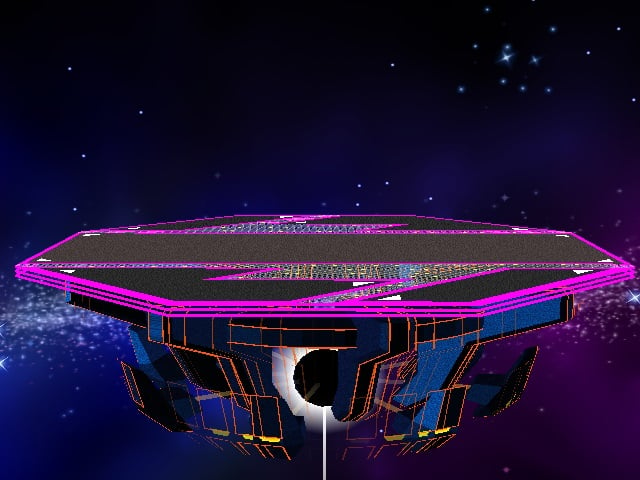Final Destination (SSBM)
- This article is about the Super Smash Bros. Melee stage. For information on its Super Smash Bros. counterpart, see Final Destination (SSB). For information on the stage from Super Smash Bros. Brawl, see Final Destination (SSBB).
| Final Destination | |
|---|---|

| |
| Universe | Super Smash Bros. |
| Appears in | SSBM |
| Availability | Unlockable |
Final Destination, sometimes abbreviated as FD or Final D, is a neutral stage in Super Smash Bros. Melee that players often use in tournament battles. It is unlocked by clearing every event match.
In Classic mode, the player fights Master Hand and Crazy Hand on this stage; in Adventure mode, Bowser and Giga Bowser; in All-Star Mode, Roy and any of his teammates. Some event matches are also played here.
This stage is very similar to Master Hand's Residence.
Controversy in competitive play
Some players believe that Final Destination is one of the most fair levels; others do not consider this true. Certain elements of gameplay are dominant on this stage. For instance, projectile users have an advantage on Final Destination, as there are no platforms for enemies to escape to or to interrupt projectiles. Since many characters have projectiles, the game balance tends to lead towards the ones who have the abilities to counter them. It also favors chain throwing because it is the widest available perfectly flat space, an environment suited to chain throws that move the enemy across stage (often due to DI). Additionally, the excess free space make camping a viable option for fast characters like Fox, Falco, Captain Falcon and Marth.
While a fair number of players who call it cheap or accuse it of being balance-skewed, there is no matchup or strategy that has been proven completely unwinnable on this stage. The primary effect that Final Destination tends to have on competitive play is that it heightens the advantage that high-tiered characters have in their best matchups. For instance, Jigglypuff against Fox runs fairly the same on Final Destination as it does on the Dream Land stage, in terms of wins and losses. However, Bowser tends to fare more poorly than normal on Final Destination, particularly against projectile-using characters, because his lack of non-interruptable moves, his large hitbox, and his short overall jump height make him an excellent target of projectile abuse, which can be mitigated in stages with platforms.
Some say that by adding additional options for characters, platforms expand gameplay and allow smashers to play more creatively. The inverse of this argument is that Final Destination removes options and therefore makes gameplay more rigid and pre-defined. However, neither of these positions are a comprehensive argument for banning the stage. As mentioned before, ranged, chain throwing and juggling characters gain most from this stage, and the game mechanics still allow for a large degree of varied play and styles, some of which are not possible with platforms. For instance, under-platform camping (a technique where a character with good priority and vertical melee range hides under a platform to prevent his opponents from attacking with Air Attacks) is invalidated here, forcing characters that rely on camping (such as Peach and Marth) to take the offense occasionally or lose to a stronger projectile or approach. Additionally, the distant side and bottom blastlines enhance the importance of edge-guarding and recovery, so while a projectile such as Falco's Blaster or Doctor Mario's Megavitamins can control the stage and rack up easy damage, their poor recoveries are amplified.
Classically, the notion of a high level of balance on Final Destination comes from traditional 2-d fighters; almost all fighting games prior to SSB take place on fixed stages with fixed edges, and are balanced to play as such. All in all, the stage is considered balanced for tournament because it allows all characters to move effectively and evade and attack properly in melee combat, and because the imbalances it creates are not dissimilar to the imbalances created by Pokémon Stadium and Fountain of Dreams - largely character and matchup based, and situational. Additionally, competitive play at the high levels of fighting games, and the tournament scene for any game involves creating and researching situations where the used character selections gain slight, but not overwhelming advantages; therefore, the player with the most stage knowledge is most likely to pick the correct stage and gain an advantage. Advanced stage selection can counter an advanced player's particular skillset, however, not in such a way that the same player cannot use his other basic and advanced skillsets to overcome the issue, and this is the scale that balance rests upon. Advanced Slob Picks are used in tournament stage selection to prevent exploitation by game winners or negative variance and a minimized level selection that a full Random, neutral stage select would give. If feeling that a character or matchup will do poorly on Final Destination, an option to ban it may be exercised, or simply another stage picked.
| Stages in Super Smash Bros. Melee | |
|---|---|
| Starter stages | Brinstar · Corneria · Fountain of Dreams · Great Bay · Green Greens · Icicle Mountain · Jungle Japes · Kongo Jungle · Mushroom Kingdom · Mute City · Onett · Pokémon Stadium · Princess Peach's Castle · Rainbow Cruise · Temple · Venom · Yoshi's Island · Yoshi's Story |
| Unlockable stages | Battlefield · Big Blue · Brinstar Depths · Final Destination · Flat Zone · Fourside · Mushroom Kingdom II · Poké Floats |
| Dream Land · Kongo Jungle · Yoshi's Island | |